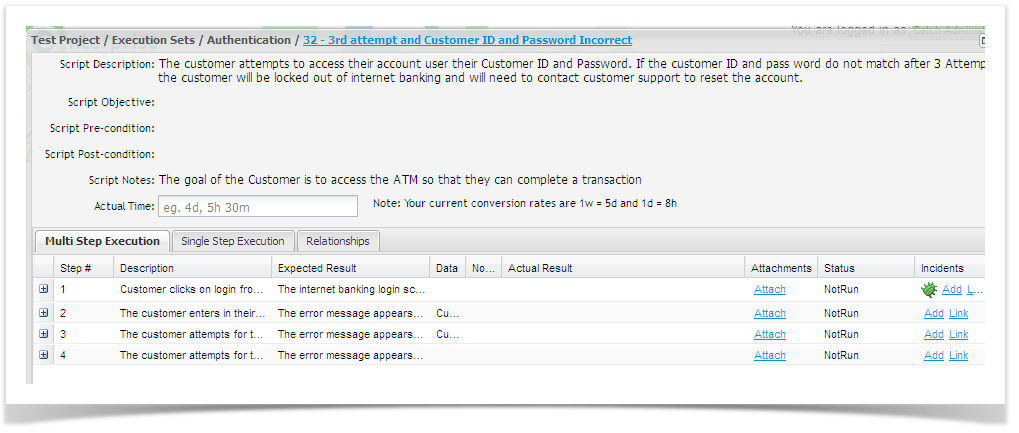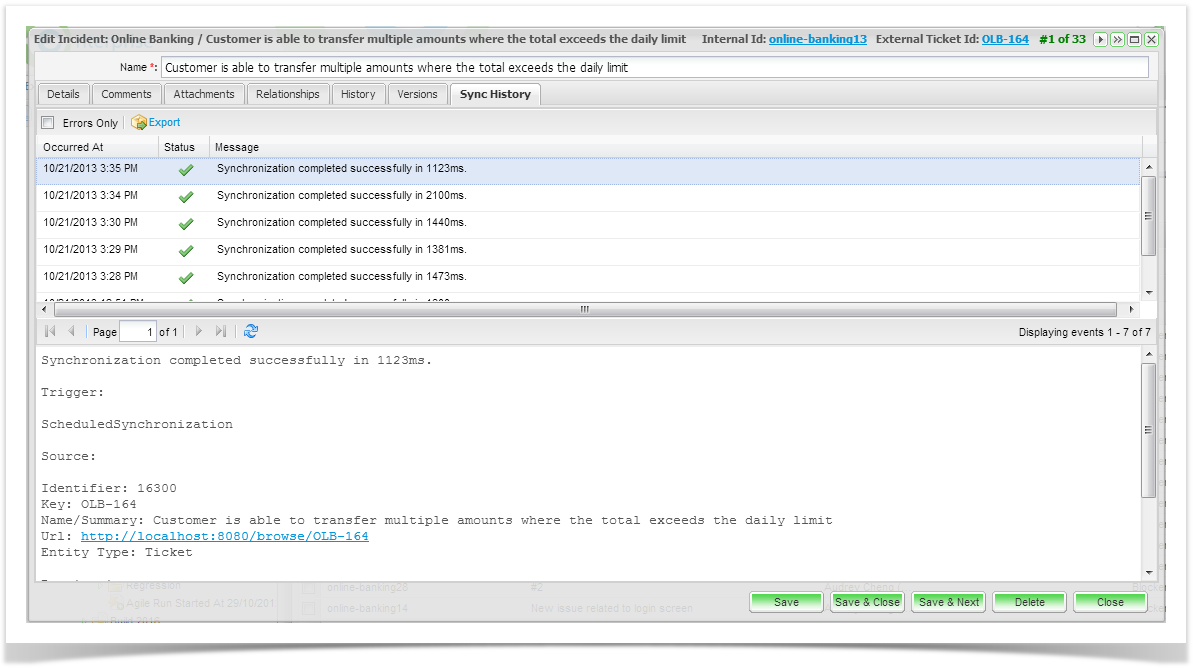If an incident is found during test execution it can be logged at the point it is discovered. Enterprise Tester has an internal defect tracker and can also integrate with external defect trackers, if required.
To synchronize with an external system like JIRA or TFS, you or your system administrator will first need to set up the integration and a project link. Once these have been configured, all new incidents created in Enterprise Tester will be automatically synchronized into the external system.
Adding Incidents During Testing
Multi-step Execution
When an incident is discovered during testing, click on the Add link under the Incident column for the relevant step.
Single Step Execution
From the single step execution screen, you can add an incident under the step incident section on the bottom left by clicking on "New".
The Add Incident screen will display.
Details Tab
Here is a list of inbuilt fields on the incident screen. The fields available on your screen may differ depending on the field configuration set by your system administrator.
| Name | A brief description of the incident. |
| Synchronize To | This field will automatically populate with all of the project links that you have configured for this project. You can easily remove project links by clicking on them |
| Raised By | This is a non-editable field that will record the user who logged the incident. |
| Type | Select the type of issue from the from the picklist or begin typing to find all matching values. |
| Priority | Select the priority the from the picklist or begin typing to find all matching values. |
| Components | Select the component from the picklist or begin typing to find all matching values. |
| Affected Versions | Select the versions that are affected by the incident or begin typing to find all matching values. |
| Fixed Versions | Select the version that the incident should be fixed in or begin typing to find all matching values. |
| Assign To | Select the user from the pick list. Note that this field only provides a list of Enterprise Tester users |
| Description | Enterprise Tester automatically adds a description that captures all the details provided in the test execution for you. You can add further details as required. |
| Status | Select the status from the pick list or begin typing to find all matching values. |
Enterprise Tester also supports custom fields and your system administrator may have configured an number of these for your incident screen depending on the requirements of your organization or project.
Once you have completed entering in the details of your incident, click on 'Save'. The incident will now be logged both in Enterprise Tester and in the external defect tracking system if configured.
If you refresh the screen you should now see that some additional details have been added to your incident. In the top right corner, you'll notice that a hyperlink back to the JIRA or TFS defect is now displayed (called the External Ticket ID) . You'll also notice that an external Links field has been added that lists all the external systems this incident has been synchronized to.
Comments Tab
On the comments tab you can add any additional comments that you wish to make on the incident. If you are synchronizing incidents with an external system, the comments in this tab will be updated with all comments made in either Enterprise Tester or the External System.
Attachments Tab
You can view and edit the attachments of an incident from the Attachments tab. A list will appear showing for each attachment the name, size and when it was uploaded.
You can also add attachments and screen shots to the incident. To do this:
- Click on the ‘Attachment’ tab of the incident and click on Paste Image to paste an image from your clipboard or click on ‘Attach’ to add a file.
The Add Attachment dialog will appear. - Click on browse and navigate to select the required file.
- Enter a name for the attachment and click on ‘Submit’.
- Click on ‘Save’ to save the incident
The attachment will now be added to the incident. Note that the attachment will also be created in the associated external system ticket that this incident is synchronized with.
Attachments from your external system will also be added here if you are synchronizing in both direction (e.g. ET to JIRA and JIRA to ET).
To delete an attachment, select the attachment and click on the delete button.
Relationships Tab
You can view and manage Incident Relationships from the Relationships tab.
Associated Requirements, Scripts, Script Runs, Automated Tests, Automated Test Runs and Incident relationships are displayed. These relationships are created automatically when an incident is raised during a test run. When an incident is raised during testing, it will automatically be associated to the run, the master script (in the Script Library) and the requirement covered by the script.
Editing Relationships
You cannot edit incident relationships. Relationships are based on the the steps which the incident is linked to within automated test runs, script runs and agile runs.
History Tab
The history table allows you to view the changes made to an incident over time, with support for filtering by property name, user, and date range.
- Select the History tab of the incident when you have the incident open for editing - the history of changes will be displayed.
You can filter the list of changes displayed by selecting from the filters below and clicking on ‘Search’.
Field
Select the field that you want to filter by
User
Select the user you want to filter by
Date From
Select the start date you want to filter by
Date To
Select the end date you want to filter by
Change ID
Select the Change ID you want to filter by
- The filtered list will be displayed.
- To clear the filter, click on ‘Reset’.
Version Tab
Enterprise Tester also creates versions of the incident each time a set of changes are made. The Versions tab lists the versions that have been created over time and provides the following information.
Version | Sequential version numbers |
Created At | Timestamp at which the version was created |
Created By | The user that made the change |
Comment | Comments regarding the source of the version |
This tab also displays detailed information for the selected version showing the difference between that version and the latest version. Details provided are:
Property | The name of the property |
Value (latest ver) | The current value of the property for the version |
Value (selected ver) | The value of the property for the selected version |
Sync History Tab
On the Synchronization History Tab, you can view a list of all synchronization events. A list will appear showing the date and time of each synchronization that has updated the incident details.
You can filter the synchronization events to show only errors by selecting the Errors Only option. This is useful when troubleshooting synchronization issues. You can also export your errors out to a CSV file which is useful to provide to the Catch Support team when requesting help with troubleshooting failed synchronizations.









